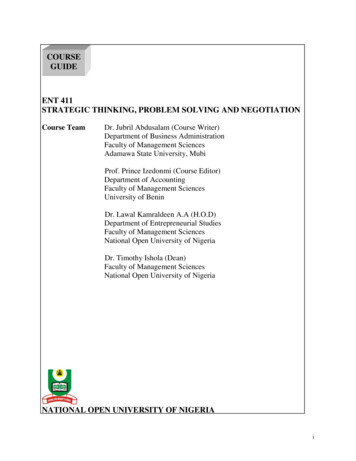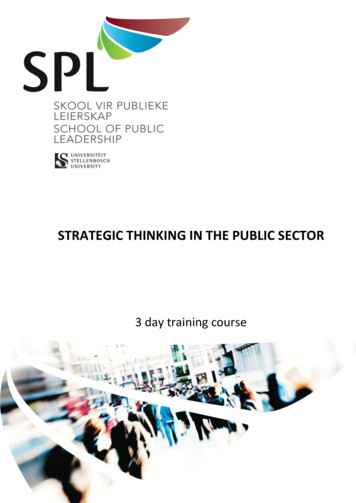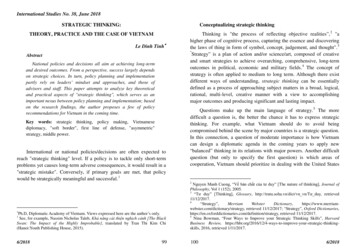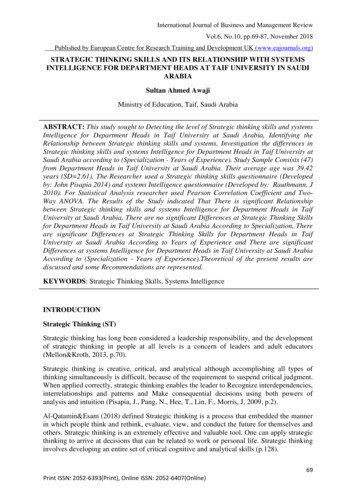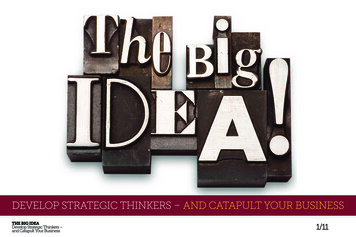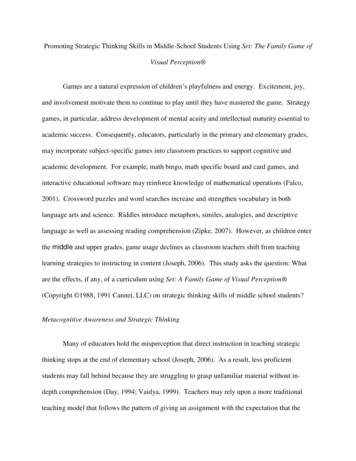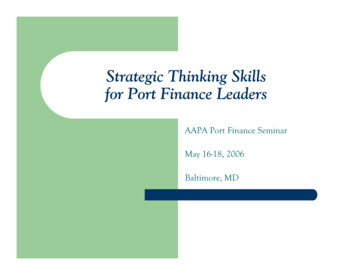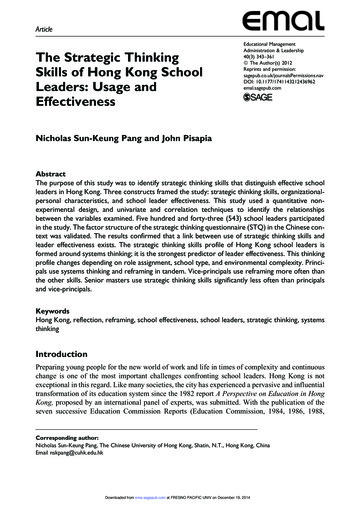
Transcription
ArticleThe Strategic ThinkingSkills of Hong Kong SchoolLeaders: Usage andEffectivenessEducational ManagementAdministration & Leadership40(3) 343–361ª The Author(s) 2012Reprints and I: 10.1177/1741143212436962emal.sagepub.comNicholas Sun-Keung Pang and John PisapiaAbstractThe purpose of this study was to identify strategic thinking skills that distinguish effective schoolleaders in Hong Kong. Three constructs framed the study: strategic thinking skills, organizationalpersonal characteristics, and school leader effectiveness. This study used a quantitative nonexperimental design, and univariate and correlation techniques to identify the relationshipsbetween the variables examined. Five hundred and forty-three (543) school leaders participatedin the study. The factor structure of the strategic thinking questionnaire (STQ) in the Chinese context was validated. The results confirmed that a link between use of strategic thinking skills andleader effectiveness exists. The strategic thinking skills profile of Hong Kong school leaders isformed around systems thinking; it is the strongest predictor of leader effectiveness. This thinkingprofile changes depending on role assignment, school type, and environmental complexity. Principals use systems thinking and reframing in tandem. Vice-principals use reframing more often thanthe other skills. Senior masters use strategic thinking skills significantly less often than principalsand vice-principals.KeywordsHong Kong, reflection, reframing, school effectiveness, school leaders, strategic thinking, systemsthinkingIntroductionPreparing young people for the new world of work and life in times of complexity and continuouschange is one of the most important challenges confronting school leaders. Hong Kong is notexceptional in this regard. Like many societies, the city has experienced a pervasive and influentialtransformation of its education system since the 1982 report A Perspective on Education in HongKong, proposed by an international panel of experts, was submitted. With the publication of theseven successive Education Commission Reports (Education Commission, 1984, 1986, 1988,Corresponding author:Nicholas Sun-Keung Pang, The Chinese University of Hong Kong, Shatin, N.T., Hong Kong, ChinaEmail nskpang@cuhk.edu.hkDownloaded from ema.sagepub.com at FRESNO PACIFIC UNIV on December 19, 2014
344Educational Management Administration & Leadership 40(3)1990, 1992, 1996, 1997), The School Management Initiative (Education and Manpower Branchand Education Department, 1991) and Information Technology for Learning in a New Era(Education and Manpower Bureau, 1998), the city experienced a pervasive and influential transformation of its education system. These changes started with remedying inadequacies of teachertraining (Education Commission, 1984, 1992), enhancement of management initiatives focused onincreasing delegation, empowerment, teacher autonomy, accountability and parental involvement(Education and Manpower Branch and Education Department, 1991), school self evaluation andquality assurance inspections (Education Commission, 1997), promotion of information technology throughout all aspects of learning and teaching (Education and Manpower Bureau, 1998),development of a school-based curriculum that emphasizes helping students develop a global outlook and equipping them with a repertoire of skills and the positive attitudes required in order torespect knowledge and to learn how to learn’ (Curriculum Development Council, 2000: 1). At theturn of the new millennium, the Hong Kong Education Commission launched another extensivereview of curriculum, academic structure and the assessment mechanism at various stages, as wellas the interface between different stages of education and all initiatives asked for all school leadersand teachers for continuous professional development (ACTEQ, 2003).These waves of change have led to complexity and sometimes ambiguity and chaos whichrequired that Hong Kong school leaders to think and act differently than before. These conditionscreated opportunities for growth, opportunity, innovation, threat, disorientation and upheaval.However, whether leaders are able to appreciate change depends very much on their attitude inperceiving it.It is generally agreed that dealing with rapid, complex and often discontinuous change requiresthe ability to think and act strategically (Pisapia, 2009). In this regard, several promising new practices have developed in Hong Kong such as schools transforming into learning communities (Pang,2006a; Pang and Cheung, 2004), and attempts for school leaders to move from hierarchical, supervisory and controlling roles to facilitative and supportive roles (Pang, 2006b). But generally, thereis an over reliance on linearity which does not fit with today’s realities of fast and furious change(Schreyogg and Noss, 2000; Weick and Quinn, 1999). Pisapia (2009) notes that one of the reasonsleaders who find themselves in such messy, chaotic, complex environments fail is they are trainedin and rely upon a linear thinking mindset that does not work in situations characterized byambiguity and complexity. They are unable to identify critical societal and institutional forcesimpacting their environment and thus do not connect their organizations to the current majorthemes associated with success.Modern leaders must possess a strategic mindset, which is developed through the application ofadvanced cognitive capabilities. Dweck (2006), Kegan and Leahy (2009) and Pisapia (2009) haveargued persuasively how well-developed methods of processing information, training, andexperience leads to mindsets that hinder attempts to achieve adaptive change. They conclude thatmindset—our learned assumptions and methods—drive every aspect of our lives, from work toplay to relationships. If they are correct, then the ability of school leaders to deal with change liesin how school leaders think and how they help their members prepare for continuous professionaldevelopment and school improvement.Study AimsThe purpose of this study is to identify the level of use of strategic thinking skills that can distinguish effective school leaders in Hong Kong. The questions which guided the study asked: (1)Downloaded from ema.sagepub.com at FRESNO PACIFIC UNIV on December 19, 2014
Pang and Pisapia: The Strategic Thinking Skills of Hong Kong School Leaders345What is the level of use of strategic thinking skills of Hong Kong school leaders? (2) Is this level ofusage moderated by personal and organizational characteristics of the leaders? (3) Is the level ofuse of strategic thinking skills linked to leader effectiveness?Importance of the studyThis study is important because it inquires into the ability of school leaders to think in a strategicway, which is critically important in a system of self-management, such as that found in the HongKong school system. Although this assumption has gone largely unnoticed in the empirical literature, Wong (2010) reported that in a study of the differences of leadership perspectives of HongKong teacher and principals; teachers view strategic thinking as a more important skill than doprincipals. Second, if a relationship between thinking and effectiveness can be established, trainingprograms specific to school leaders’ could be developed that maximize leader effectiveness.Finally, this study adds to the developing strategic leadership literature and results can help identify potential outstanding leaders and future research areas.Conceptual/Theoretical FrameworkThe three constructs that framed the study: leader thinking; organizational-personal characteristics;and leader effectiveness are discussed in the following paragraphs.The Strategic Thinking FrameworkIn the management literature, it is commonly agreed that that strategic thinking is important leaderskill; there is less clarity on its core elements. Liedtka’s (1998) elements include system perspective, focused intent, thinking in time, hypothesis-driven and intelligent opportunism. She (1998:32) says, ‘A strategic thinker has a mental model of the complete end-to-end system of value creation, his or her role within it, and an understanding of the competencies it contains’. O’Shannassy(2003) proposed a model for what he called the Modern Strategic Management Process in whichstrategic thinking is the starting point. He (2003: 57) said: ‘ . . . strategic thinking combines creativity and analysis which facilitates a problem solving or hypothesis oriented approach’. Bonn(2005) suggested that the key elements of strategic thinking are systems thinking, creativity andvision. She (2005: 340) said ‘research on strategic thinking should address the following levels:(a) the characteristics of an individual strategic thinker; (b) the dynamics that take place withina group of individuals; and (c) the organization context’. To clarify our terms, strategic thinkingin the broader sense is the result of the interaction between leadership characteristics expressedby skills, experiences and abilities of the leaders, and the characteristics of the internal and externalenvironment of the organization (Daghir and Al Zaydi, 2005). Our focus in this study is on theleader’s thinking skills that support the way they make sense of their environment. The assumptionis that if leaders possess these skills they will be better able to (1) recognize interdependencies,interrelationships and patterns, and (2) make consequential decisions using both powers of analysisand intuition.Pisapia, Reyes-Guerra and Coukos-Semmel (2005), concurring with Daghir and Al Zaydi’s(2005) finding of a lack of appropriate instrumentation to test this assumption, identified—systemsthinking, reflection and reframing—as important concepts scholars associated with strategicthinking (Dewey 1933; Simon, 1957; Argyris and Schön, 1978; Schön, 1983; Morgan, 1987; SengeDownloaded from ema.sagepub.com at FRESNO PACIFIC UNIV on December 19, 2014
346Educational Management Administration & Leadership 40(3)Table 1. Descriptions of the thinking skills found in the strategic thinking questionnaireStrategic thinking skillsDescriptionSystems thinkingSystems thinking refers to the leader’s ability to see systems holistically byunderstanding the properties, forces, patterns and interrelationships thatshape the behavior of the system, which hence provides options for action.Reflecting means the ability to weave logical and rational thinking, through theuse of perceptions, experience and information, to make judgments on whathas happened, and creation of intuitive principles that guide future actions.Reframing refers to the leader’s ability to switch attention across multipleperspectives, frames, mental models, and paradigms to generate new insightsand options for action.ReflectionReframing1990; Bolman and Deal, 1994; Halpren, 1996; Cohen et al., 2000). From their review of theliterature, Pisapia and his colleagues further defined the three skills and then created items todevelop a valid and reliable instrument to study a leader’s ability to recognize patterns, interdependencies and make consequential decisions. They hypothesized that effective leaders use theseskills differently than less effective leaders, especially under conditions of complexity. The skills,incorporated into what is now called the strategic thinking questionnaire (STQ), are described onTable 1.The use of strategic thinking skills has been studied in leaders. Chilcoat (1995), for example, suggests that effective leaders demonstrate more complex mental processes than ineffective leaders. Moreover, Leithwood and Steinbach (1992) believe that efforts to improve theeffectiveness of school leaders may be more productive if more consideration were givento improve the quality of thinking and problem solving rather than simply focusing on actionsor behaviors.These skills have also been studied using the STQ. For instance, Pisapia, Reyes-Guerra andYasin (2006) conducted a study of 136 leaders from profit (40 percent) and non-profit (60 percent)organizations. The study identified (1) a cumulative effect of strategic thinking skills and selfreported leader effectiveness (r ¼ 0.279, p 0.001, ES ¼ 0.43); (2) Reframing (r ¼ 0.219, p 0.01, ES ¼ 0.08), reflection (r ¼ 0.243, p 0.05, ES ¼ 0.07); and systems thinking (r ¼ 0.260,p 0.05, ES ¼ 0.09) were significantly correlated with leader effectiveness. Systems thinkingexplained most of the variance in the effectiveness variable.Zsiga (2008) applied the STQ to levels of self-directed learning readiness, strategic thinking,and leader effectiveness in Young Men’s Christian Association (YMCA) directors. The analysisof the 471 responses demonstrated robust correlations between self-directed learning readinessand strategic thinking (r ¼ 0.58, p 0.001). Leader effectiveness, on an objective measure, correlated similarly and significantly with these two constructs (r ¼ 0.10, p 0.05). These correlations present indicate that a positive relationship exists between self-directed learning levels,strategic thinking levels, and objective leader effectiveness. The study also provided evidenceof (1) a positive relationship between strategic thinking [total] and leader effectiveness, (2)reframing and leader effectiveness, (3) moderation of strategic thinking and leader effectivenessby ethnicity and (4) a robust association of the strategic thinking skills scale with the self directedlearning scale.The use of strategic thinking skills has also been studied in advanced graduate students preparing for leadership positions. For instance, Pisapia et al. (2009) conducted a comparative study ofDownloaded from ema.sagepub.com at FRESNO PACIFIC UNIV on December 19, 2014
Pang and Pisapia: The Strategic Thinking Skills of Hong Kong School Leaders347328 students in graduate administration programs in Hong Kong (HK), Shanghai, Borneo, KulaLumpur (KL) and the USA. They concluded that the variance in the use of strategic thinking skillsuse was more a function of age of the respondents, rather than location or gender. Reflection andsystems thinking skill usage rose incrementally for each location, as participants got older. Theyoffered an alternative explanation that rather than an age bias, the age variable could be a proxy forexperience and/or education, which are likely moderators of thinking skills.Penney (2010) investigated the relationship of the use of strategic thinking skills and the useof technology by 122 graduates of the National Executive Fire Chiefs Academy in the USA.She found that (1) education level and length of service and age were positively associated withhigher use of strategic thinking skills, and that (2) age was a moderator of the relationship ofsystems thinking and reflecting and information and computer technology comfort (t ¼ -2.359;p ¼ 0.020).Pisapia and Glick-Cuenot (2010) applied the STQ to entering freshman to determine if strategicthinking skills possessed by students before they took university courses were related to gradepoint average and retention. Significant correlations were found between systems thinking, (r ¼0.249, p 0.000) and reflection (r ¼ 0.200, p 0.002) and grade point average.In summary, statistical analyses of STQ administrations yields five major impressions. First,strategic thinking is associated with self reported and objective measures of leader effectiveness.Supervisors and managers in our samples score lower than the executives; as expected. However,the high performers (the top 20 percent on effectiveness scores) in each management category usedthese mental skills significantly more often than less successful managers. Second, there is a cumulative impact when the three capabilities which form the strategic thinking construct are used. Thestrength of the relationship between strategic thinking and leader effectiveness increases as leadersuse the three dimensions in tandem. Third, there is a significant relationship between the use ofstrategic thinking skills and self directed learning. Fourth, the use of these skills improves with ageand experience—the younger you are the less you use these skills. Finally, the STQ appears free ofcultural and gender bias; but reveals an age bias.Environmental and Personal CharacteristicsAs many scholars have noted, when it comes to leadership context is important (Leavy andWilson, 1994; Hinkin and Tracey, 1999; Osborn et al., 2002; Pisapia 2009). For someresearchers such as Kolb et al. (2001), organizational environment is an important factorinfluencing how the leader behaves. According to them, environment dictates the choice ofstructure and the way the communication is implemented in the organization. Hoy and Miskel(1987) identified four dimensions that could influence leader actions: structural properties ofthe organization, organizational climate, role characteristics and subordinate characteristics. Inour study, the influence of environmental indicators—school type, size of staff—number ofteachers—numbers of students—were studied to determine if they are related to the use ofstrategic thinking skills.For other researchers (Luthans, 1981), personal characteristics and traits of the leader may alsoaffect their style of leadership and eventually their effectiveness. The study of leader characteristics and traits has a long history. In fact it was the first organized approach to studying leadership.This study used leader personal characteristics of—position, gender, age, working experience, andeducational degree earned—to determine if they are related to the use of strategic thinking skills.Downloaded from ema.sagepub.com at FRESNO PACIFIC UNIV on December 19, 2014
348Educational Management Administration & Leadership 40(3)Leader EffectivenessLuthans (1988: 137) differentiated successful managers from effective managers. Accordingto him successful managers refers to ‘those who have been promoted relatively quickly’ andeffective mangers to ‘those who have satisfied, committed subordinates and high performingunits’. Other scholars have defined leader effectiveness in different ways. For Pisapia (2009)effectiveness is dependent on how proficiently the organization responds and readapts to itsever-evolving context and the ability of the leader to continually renew the systems of learning within the organization. Kolb et al. (2001) suggest that to be successful or effective,today’s managers must possess the capacity to analyze complex situations accurately andchoose appropriate responses. Pondy (1983) and Weick (1983) considered pragmatic thinkingand action to be basic to the success or effectiveness of an executive (cited in Bass 1990a).Bass (1990b: 106), believed that successful executives are those who are able to ‘unite theintuitive and the rational and respond to behavior, not intentions or preconceptions’. In hislater writing, he maintained that in order to be effective and successful, leaders need to be‘truly transformational in identifying and publicizing the inadequacy of defensive pseudosolutions’ (Bass, 1998: 43). He also believed that in order for leaders to be successful or effective in crisis conditions, they must be transformational—able to rise above what theirfollowers see as their immediate needs and appropriate reactions. Other scholars, such asCollins and Porras (1997), use objective criteria such as followers’ productivity, that is, theamount of work completed, or group and organizational outcomes.This study adopts the Luthans’ view that of leader effectiveness is the result of satisfying committed subordinates and high performing units as the criterion variable. To represent managerialeffectiveness, 10 effectiveness items were formed from the literature and placed in the primarydata collection tool under three dimensions of effectiveness important to strategic leaders: leadership, management, and performance. Effectiveness items included those related to leadership: (1)successful provision of value to the organization (Collins, 2001); (2) bringing about change in theorganization (Kotter, 1996; Leithwood et al., 1999; Collins, 2001); (3) satisfying the needs of theorganization’s external stakeholders (Burns, 1978); and (4) empowering followers (Senge, 1990;Kotter 1996; Leithwood et al., 1999). Items that related to management included: (1) maintainingan orderly work environment (Heifetz, 1994); and (2) satisfying the needs of the organization’sinternal stakeholders (Barnard, 1938; Burns, 1978; Bass and Avolio, 1994; Kotter, 1996; Leithwoodet al., 1999; Collins, 2001). Also included were items that related to organizational performance,for example, success in meeting the goals of the organization’s mission or vision (Bass, 1990b;Bass and Avolio, 1994; Kotter, 1996; Collins and Porras, 1997; Leithwood et al., 1999; Collins,2001).MethodsResearch DesignThis study employed a quantitative non-experimental design. The strategic thinking skills—reflection, reframing and systems thinking—were selected as the predictor variables andleader effectiveness the criterion variable. The influence of environmental and personal characteristics was also studied to determine their impact on the use of participants’ strategicthinking skills.Downloaded from ema.sagepub.com at FRESNO PACIFIC UNIV on December 19, 2014
Pang and Pisapia: The Strategic Thinking Skills of Hong Kong School Leaders349ParticipantsA random sample of approximately three school leaders at 200 primary and 200 secondary schoolsin Hong Kong were invited to participate in the study. A total of 531 respondents (including 183principals, 204 vice-principals and 141 senior masters [program coordinators]; 3 missing) returnedusable questionnaires, which accounted to about 45 percent return rate. Forty-seven percent (n ¼248) were male and 51.2 percent (n ¼ 272) were female; 11 respondents did not provide information. The respondents’ ages in years ranged from 23 to 60 years of age (M ¼ 47.48, SD ¼ 7.13).The respondents’ experience in leadership positions ranged from one year to 38 years (M ¼ 7.18,SD ¼ 6.22). Fifty-six percent of the respondents held bachelors’ degrees, 37 percent masters’degrees, 2 percent doctorate degrees, and 5 percent certificate or associate degrees.Data Collection—InstrumentsThe strategic thinking questionnaire (STQv1) was the primary data collection instrument for thisstudy. The STQv1 collects data on participant use of three thinking skills—reflection, reframingand systems thinking. The STQ (44 items) asks respondents to rate how often they use these skillswhen confronted with problems, dilemmas, and/or opportunities on a Likert-type scale, where 1 ¼rarely or almost never, 2 ¼ once in a while, 3 ¼ sometimes, 4 ¼ often, and 5 ¼ frequently or almostalways. Average to above average scores on the STQ suggest that the respondent is effective inusing the strategic thinking skills, meaning that he or she is most likely to possess the skills tobe a strategic thinker. The higher the scores, the more positive the prediction for effective functioning in meeting environmental demands and pressures. On the other hand, an inability to be aneffective strategic thinker is suggested by low scores.The strategic thinking questionnaire (STQ) is a self-report instrument that includes two indicators: (1) omission rate (number of omitted responses); and (2) an inconsistency index (degree ofresponse inconsistency) to overcome validity issues with such instruments. If scores on the paireditems deviated more than one point the case was eliminated from the analyses. It also includesseven reverse scored items to reduce the danger of patterned answers. Five hundred and fortythree responses were received. After application of these tests, 12 cases were removed leaving531 cases for analysis in this study.The base STQ is accompanied by 10 leader effectiveness items (alpha 0.897), and by 9 environmental and personal characteristics questions for a total of 63 items. The translation from Englishto Chinese was achieved in three steps. The STQv1 was first translated into Chinese by Hong Kongbased academicians. It was then retranslated into English and reviewed by STQ developers; thenback-translated. The back translated version and the original version were found to be quite similar. A few terms were modified to improve the translation. The content validity of the translatedversion was then verified by a panel of three experienced Hong Kong educational leaders withPhDs in educational administration.The Chinese version of the STQ was psychometrically tested with the Hong Kong dataset.A confirmatory factor analyses (CFA) was performed with the strategic thinking items using theprincipal component analysis (PCA) with direct oblimin of oblique rotation method to extract thecommon factors in the STQ. As seen in Table 2, the results of the PCA confirmed the constructvalidity of the STQ. The strategic thinking scale that resulted from the PCA is comprised of threesubscales: systems thinking (10 items), reframing (7 items), and reflecting (6 items).Downloaded from ema.sagepub.com at FRESNO PACIFIC UNIV on December 19, 2014
350Educational Management Administration & Leadership 40(3)Table 2. Pattern matrix from the principal component analysis with direct oblimin of oblique rotation for thethree cognitive processes of strategic thinkingComponent1 Systemsthinking 2 Reframing 3 ReflectingItem no. Track trends by asking everyone ‘what is new?’See patterns in ambiguous information?Track trends by asking those around you ‘what is changing?’Look at how things are interconnected to find a specificproblem that seems to influence the greater problem?Look for an existing common goal when two parties arecompeting?Search for patterns when confronted with complexinformation?Increase capacity of an area in your organization before theactual demand hits?Create and examine a larger number of possible solutionswhen the problem is more complex?Ignore past decisions and their results when consideringrelated present day situations?Ask WHY questions to develop an understanding ofproblems presented to you?Not take into account the real life implications whenthinking about decisions and actions you make?Find that external environmental changes do not requireinternal organizational changes?Create a pre-conceived solution to a problem before it hasbeen clearly defined or understood?Evaluate a situation using a single viewpoint?First judge the problem at its face value and create plans tosolve it before then looking at other viewpoints?Find that first hand experience does not change yourperspective on a situation?Avoid discussions with critics and challengers?Accept that your dearest beliefs could be mistaken whenthinking about past decisions and actions?Acknowledge the limitations of your own perspective?Engage in discussions with those who hold a different worldview?Seek coaching by professionals or colleagues when thinkingabout past decisions and actions?Engage in discussions with those who have different beliefsor who make different assumptions about a situation?Discover how you could have handled a situation betterwhen thinking about past decisions and actions?Eigenvalue% of variance explainedReliability0.6780.6170.6120.610 0.1690.097 0.1440.110 0.103 0.1180.0930.1030.5910.041 0.459 0.2010.1780.3380.0420.2470.0200.746 0.0880.0850.669 0.0600.0020.650 0.0400.020 0.1330.5490.4840.0100.012 0.1920.4630.1050.103 0.1250.449 0.0870.0820.724 0.1130.1990.079 0.0280.6890.5670.107 0.792.48610.810.681.3355.890.69Downloaded from ema.sagepub.com at FRESNO PACIFIC UNIV on December 19, 2014
Pang and Pisapia: The Strategic Thinking Skills of Hong Kong School Leaders351Data AnalysisDescriptive statistics, multiple univariate analyses of variance and regression analyses were preformed to evaluate the relationship among the variables. All of the data collected for this studywere entered into SPSS v16.0 in order to run the analyses.Limitations of the StudyResults from this study are limited by operations. The data were self reported. The reliability ofusing self ratings as a measure in research studies has been a reviewed by a number of writers without reaching conclusive universal consensus on their effectiveness (Harris and Schaubroeck, 1988;Atwater and Yammarino, 1992; Smither et al., 1995; Yammarino and Atwater, 1997; Weisbandand Atwater, 1999).Despite Spector’s (1992) claim that such data is not as limited as commonly expected, and withthe lack of a full consensus, there are still indications of a tendency for self-reported data to beinflated. Therefore, the STQ is designed to elicit individual preferences and behaviors withoutinfluencing the respondent toward or away from any particular selection. It contains safeguardsidentified in previous paragraphs to overcome the effects of self-reporting. These safeguards wereapplied and cases were removed before the data was analyzed. Base our experience with otherapplications of the STQ we are confident that the data as it relates to the use of strategic thinkingskills is solid and can be depended upon. We are slightly less confident of the data in regards toleader effectiveness even though the results we found are consistent with Zsiga’s (2008) studywhich used an objective measure of effectiveness.ResultsUse of Strategic Thinking SkillsThe initial two research questions asked us to determine the level of the participant’s use of strategic thinking skills, and the effect of personal and environmental characteristics on these skills.These research questions were addressed by first comparing the means for study participants onthe three strategic thinking skills. As seen on Table 3, reframing (M ¼ 3.75, SD ¼ 0.43) was usedmost often,
The use of strategic thinking skills has also been studied in advanced graduate students prepar-ing for leadership positions. For instance, Pisapia et al. (2009) conducted a comparative study of Table 1. Descriptions of the thinking skills found in the strategic thinking questionnaire Strategic thinking skills Description


